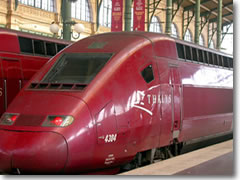Train Tips for Tightwads
Seven scintillating suggestions to reduce rail rates—Railpasses, overnight trains, student/senior discounts, reservations, and more
 The high-speed Thalys, just one of Europe's super-modern, super-efficient trains that make crisscrossing the continent not only fast and easy, but terribly Romantic.
The high-speed Thalys, just one of Europe's super-modern, super-efficient trains that make crisscrossing the continent not only fast and easy, but terribly Romantic.
The shortest distance between any two points in Europe is usually laid with train tracks. Rail travel is the most popular way to get around, and with the exception of no-frills airlines is also the cheapest and most convenient means for long-distance travel.
One big hint I will point out before we delve into the specifics: always do a load of research before deciding on the method of travel that will best fit your travel plans and budget.
Use the "Fares and Schedules" feature of at Rail Europe (www.raileurope.com) to calculate the ticket cost for each and every one of your itinerary's planned train journeys. Then figure out whether some form of railpass will save you money, or if it would behoove you to use a no-frills airline, or consider whether you'll want to rent a car for exploring the back roads of Provence or Tuscany.
Weigh all these factors before deciding on which combination of train passes, plane tickets, point-to-point rail tickets, and other means will serve you best and save you the most money. Once you have figured out when you'll be taking the train, here are some tips to help you cut costs.
VIP on the RR
Railpasses are one of the original budget tools for European travel. It's like a ticket good for unlimited travel on the trains. Railpasses come in two main flavors: The regular, consecutive day railpass gives you, say, one month in which you can ride the rails as often as you darn well please.
The cheaper flexipass version grants you a certain number of unlimited-ride days you can use, one-by-one, at any time within a set time period, usually two months. Luckily, a "day" starts the evening before so you can take advantage of overnight trains (so if you board one after 7pm, you write the next day's date on the pass).
The granddaddy of them all, of course, is the famed Eurailpass : 17 countries (NOT including Great Britain) for anywhere from 15 days to three months. The Eurail flexipass is good for 10 or 15 days of travel within two months.
Then there are flexi Selectpass , allowing you to choose of any three, four, or five adjoining Eurail countries; the European East Pass for exploring behind the old Iron Curtain; dual-country passes for more focused trips; and national railpasses . And still more varieties: rail 'n' drive passes; "partner" passes that save money for two or more traveling together...the permutations seem endless.
For far more detail on each of these kinds of passes, head to the railpasses section of this site. You can buy any Eurail pass from most travel agents, or order it on-line from Rail Europe (www.raileurope.com) .
Again to see whether you a railpass will save you money on your trip, use the search engines for point-to-point tickets at Rail Europe (www.raileurope.com). Plug in the data for all the train trips you plan to take, jot down the prices for each, add them up, and if the total is close to or greater than the cost of the railpass that will do the same job, the choice is clear.
Pocket your railpass on short trips
If you're using a flexipass, calculate quickly how much per day it's costing you. Then, every time you go to get on a train, pop over to the automated ticket machine (or, if lacking, up to a ticket agent) and check out the price for the trip you're about to take. If it costs less than a day's use of the flexipass—and you plan to travel more days than the pass is going to cover—just buy the ticket and save the railpass day for a long-haul, more expensive trip where you're really going to need it.
Boxcar Willie—But with style
The money-saving benefits of using overnight trains —where a bunk in a couchette (train compartment) costs around $20 to $30, or you can take your chances and try to find an empty couchette to occupy for free—are covered in full here.
The practical upshot: you get a cheap night's lodging plus you get where you're going whilst asleep, and are therefore not wasting a precious day of vacation time on sheer transportation. Pretty nifty!
Always travel second class
I almost forgot to include this tip because it seems so obvious. Some cars on a train are first class (with seats that are ever-so-slightly wider and cushier), some are second class. All cars in that train will get to the destination at the same time. Why pay 40% to 70% more for a bit more seat padding?
Unfortunately, adult railpasses are only offered in a first class version (though you can get youth passes in second class). Luckily, a first class ticket entitles you to sit anywhere on the train, so if you're taking an overnight run you can still use your first class ticket for the ride but book a couchette bunk in second class (much cheaper than a first class sleeping berth)—though the conductor will probably look at you funny.
>> More tips on saving money on train travel...
Related Articles |
Outside Resources |
This article was last updated in October 2006. All information was accurate at the time.
Copyright © 1998–2010 by Reid Bramblett. Author: Reid Bramblett.



 ShareThis
ShareThis
